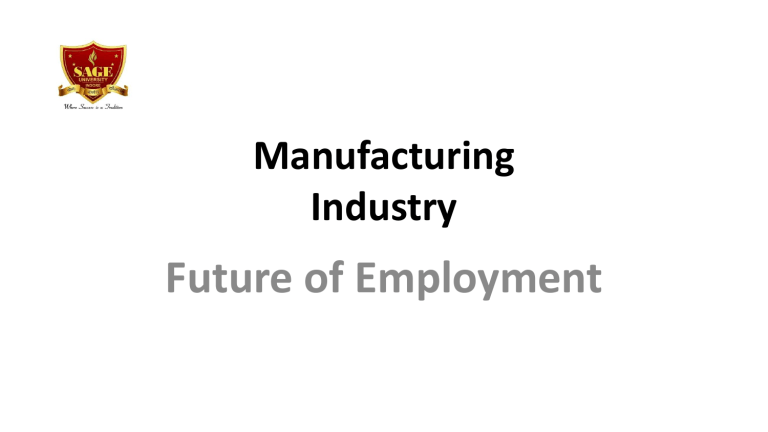
Manufacturing Industry Future of Employment Where will jobs come from in Manufacturing • 1 Sourcing Vendors Contracts • 2 Purchase Logistics Materials Management Stocking • 3 Production Machinery and Equipment Manufacturing facilities Testing and QC • 4 Distribution Logistics Payments Information and feedback • 5 Marketing and Sales Advertising and PR Repeat Orders • 6 Protection of Rights • 7R&D • Back to point 1 Popular Streams for today’s session • Engineers from Mechanical, Electronics, Electrical, Comp Sc, Bio Medical, and more. • Management Courses like Purchase and MM, Marketing and sales, Project Managers, Finance, HR • Architects, Civil Engineers, Maintenance and Diploma Engineers in core branches, MEPs • Logistics People – Space, Weights, Queing, Statistics. • Designers and Innovators • We are leaving very vast fields like Food and Agriculture and Infrastructure or Environment untouched here, as it will make the study too long and beyond relevance in today’s session. Employability Enhancers • • • • • • • • • • Communication Self Motivated Learning of Needs of New Environment and adaptability. Clear Fundamentals of your field of choice. Will to take part in creative solutions Flair to work with solution tools like Design Thinking and Finite Elements Analysis – FEA Innovative approach in practices. High stress on Quality and Excellence in output and all things in general. Get Free Learning Resources from ; EDX, Coursera, Udemy, Harvard Univ., Stanford Univ. Learning to look at things from point of view of Customers. Introduction to Industry 4.0 6 Manufacturing Technology Trends to Change Paradigms in future • • • • • • 3D Printing Nanotechnology The Internet of Things (IoT) Cloud Computing Predictive Maintenance Technology and Big Data Augmented Reality Additive Manufacturing • Dr. Guha Manogharan, Assistant Professor, ME Department at Penn State University, focuses on one of the hottest topics in the industry – Additive Manufacturing (AM), this talk briefly outlines the current state of AM technology and its applications. Dr. Manogharan shares his experience as a researcher in AM and his takeaways from working with AM industry and national labs. • FEA stands for finite element analysis, a commonly used method for multiphysics problems. Finite element analysis is defined as a numerical method which provides solutions to problems that would otherwise be difficult to obtain. In simple terms, FEA is a faster way to get results to problems that are hard to solve. • https://www.youtube.com/watch?v=kJZ2DvXcr6s Additive Manufacturing or 3D Printing 3 D Printing or Additive Manufacturing • One of the biggest news in the manufacturing technology sector in the last few years is the proliferation and application of 3D printing technology. It has caught the imagination of the general public and the manufacturing community like nothing since the invention of the personal computer and the internet. Within a few years, the technology has evolved so much that it is now possible to produce almost any component using metal, plastic, mixed materials and even human tissue. It has forced engineers and designers to think very differently when thinking about product development. As this more manufacturers adopt and use 3D printing technology, there is little doubt that 3D Printing will change the face of manufacturing forever. NanoTechnology • • • • • • • Nanotechnology is the technology of the future, but the first generation of the technology is already here. It involves the manipulation of matter on atomic, molecular and supramolecular scales; thus bringing with it super-precision manufacturing. Currently applied mostly in space technology and biotechnology, it is going to play an indispensable role in every manufacturing industry in the future. In many ways, it has already changed the world. Examples of application in nanotechnology include: Faster computer processing, Smaller memory cards that have more memory space, Clothes that last longer and keep the wearer cool in the summer, Bandages that heal wounds faster, And tennis and bowling balls that last longer. In the future, there will be nanobots (microscopic robots) that will carry drugs to specific tissues in our body. The Internet of Things (IoT) • The Internet of Things (IoT) is a revolutionary manufacturing technology that allows electronic devices connected to each other, within the existing Internet infrastructure, to communicate with one another without human intervention. An IoT device connects to the internet and is capable of generating and receiving signals. As such, the use of this technology is going to have a profound impact on the manufacturing industry. IoT enables connected devices to “talk” to each other, sending and receiving critical notifications. An example of a critical notification is a defect or damaged ping. Once the device detects a failure, the IoT connected device sends a notification to another device or a user. This type of small, but critical, application of IoT in manufacturing results in reduced downtime, increased quality, reduced waste and less overall costs. Cloud Computing • • • • Cloud computing is the practice of using a network of Internet-connected remote services along various points to store, manage, and process data. Many companies are already using cloud computing, although the manufacturing industry is still taking time to warm up to the technology due to connectivity and security concerns. Over time, to the present day, cloud computing grows more stable and reliable. Manufacturers are increasingly implementing cloud computing software in manufacturing plants spread out in various geographic areas in order to share data quickly and efficiently. In implementing cloud computing, manufacturers reduce costs, gain greater quality control, and increase the speed of production. In the future, it is feasible that all manufacturing facilities will have a connection to the cloud. Predictive Maintenance Technology and Big Data • Manufacturing industries can significantly increase their efficiency and productivity with the technologies that allow them to collect, process and measure big data in real time. • These technologies include electronic devices that connect factories through the internet and web pages that double as dashboards for controlling the processes. Predictive maintenance technology helps predict snags and defects and thus cuts downtime and costs. • In the future, manufacturers will implement big data and predictive maintenance technologies in every area of manufacturing. IoT is a part of big data and predictive technology that manufacturers are already using with remarkable success. Future readiness for core engineering, sciences, management and humanities students A course in Industrial Automation PLC- SCADA – HMI- VFD. Equally Relevant Today for Mechanical, Electronics and Information Technology Engineers. Programming Practice – Start with a Raspberry Pie- Make fun work for your profession Practice algorithms Improve Communication skills to bring assertive body language across the table. Take up online aptitude tests voluntarily. Improve Maths if you are targeting technical positions. Remain curious and connected in relevant platforms to improve timely learning and network of relevant people. Digital Marketing and Learning Design and UX . Thanking for your Time and Wishing you Best for future


